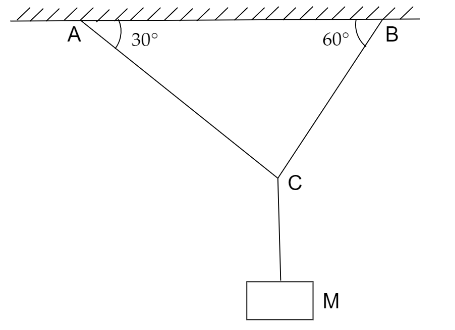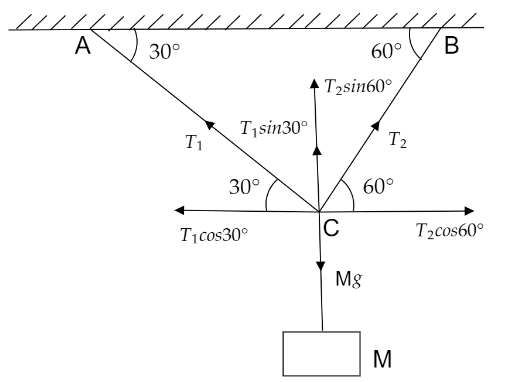
If mass $M$ is $2{\text{ }}kg$ what is the tension in string AC? (in $N$)


Answer
488.7k+ views
Hint:First of all, we have to assume two different tensions in two different strings. Then by using the vertical component and horizontal component we will find the relation between the tension in string AC and BC. The total tension of both the strings will be equal to the weight of M.
Complete step by step answer:

Let the tension in the string AC be ${T_1}$ and at BC be ${T_2}$.
We have to resolve the components of tensions of the string in AC and BC.
By equating in horizontal direction we get,
${T_1}\cos {30^ \circ } = {T_2}\cos {60^ \circ }$
Thus, we get the result as,
$\sqrt 3 {T_1} = {T_2} - - - - - \left( 1 \right)$
Given in the question M$ = 2{\text{ }}kg$
By resolving the vertical components we get,
${T_1}\sin {30^ \circ } + {T_2}\sin {60^ \circ } = {\text{M}}g$
Now we get the equation as,
$\dfrac{{{T_1}}}{2} + \dfrac{{\sqrt 3 {T_2}}}{2} = 2 \times 10$
Substituting the values of ${T_2}$ from equation $\left( 1 \right)$ we get,
$4{T_1} = 40$
$ \therefore {T_1} = 10$
So, the tension in the string AC is $10{\text{ }}N$.
Note:It must be noted that tension is a force which acts on the string. In the given diagram we use the vertically opposite angle concept to understand the tension forces more clearly. While resolving any component of force, the component which is attached to the angle is considered as $\cos $ component and the one which is away from the angle is the $\sin $ component. Tension is actually a force so it holds up the force exerted by the mass M.
Complete step by step answer:

Let the tension in the string AC be ${T_1}$ and at BC be ${T_2}$.
We have to resolve the components of tensions of the string in AC and BC.
By equating in horizontal direction we get,
${T_1}\cos {30^ \circ } = {T_2}\cos {60^ \circ }$
Thus, we get the result as,
$\sqrt 3 {T_1} = {T_2} - - - - - \left( 1 \right)$
Given in the question M$ = 2{\text{ }}kg$
By resolving the vertical components we get,
${T_1}\sin {30^ \circ } + {T_2}\sin {60^ \circ } = {\text{M}}g$
Now we get the equation as,
$\dfrac{{{T_1}}}{2} + \dfrac{{\sqrt 3 {T_2}}}{2} = 2 \times 10$
Substituting the values of ${T_2}$ from equation $\left( 1 \right)$ we get,
$4{T_1} = 40$
$ \therefore {T_1} = 10$
So, the tension in the string AC is $10{\text{ }}N$.
Note:It must be noted that tension is a force which acts on the string. In the given diagram we use the vertically opposite angle concept to understand the tension forces more clearly. While resolving any component of force, the component which is attached to the angle is considered as $\cos $ component and the one which is away from the angle is the $\sin $ component. Tension is actually a force so it holds up the force exerted by the mass M.
Recently Updated Pages
Why are manures considered better than fertilizers class 11 biology CBSE

Find the coordinates of the midpoint of the line segment class 11 maths CBSE

Distinguish between static friction limiting friction class 11 physics CBSE

The Chairman of the constituent Assembly was A Jawaharlal class 11 social science CBSE

The first National Commission on Labour NCL submitted class 11 social science CBSE

Number of all subshell of n + l 7 is A 4 B 5 C 6 D class 11 chemistry CBSE

Trending doubts
What is meant by exothermic and endothermic reactions class 11 chemistry CBSE

10 examples of friction in our daily life

One Metric ton is equal to kg A 10000 B 1000 C 100 class 11 physics CBSE

1 Quintal is equal to a 110 kg b 10 kg c 100kg d 1000 class 11 physics CBSE

Difference Between Prokaryotic Cells and Eukaryotic Cells

What are Quantum numbers Explain the quantum number class 11 chemistry CBSE




